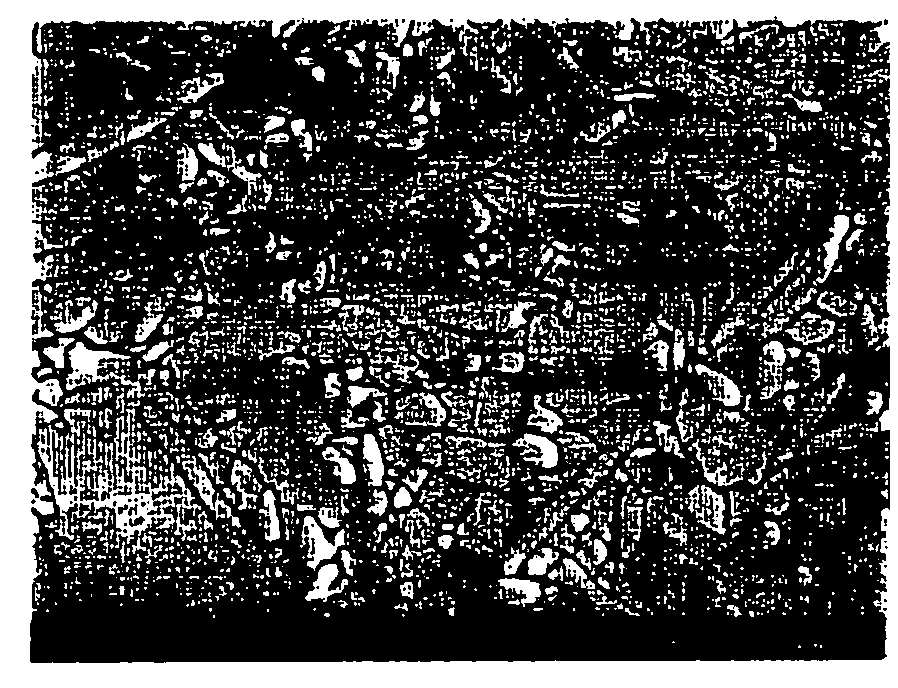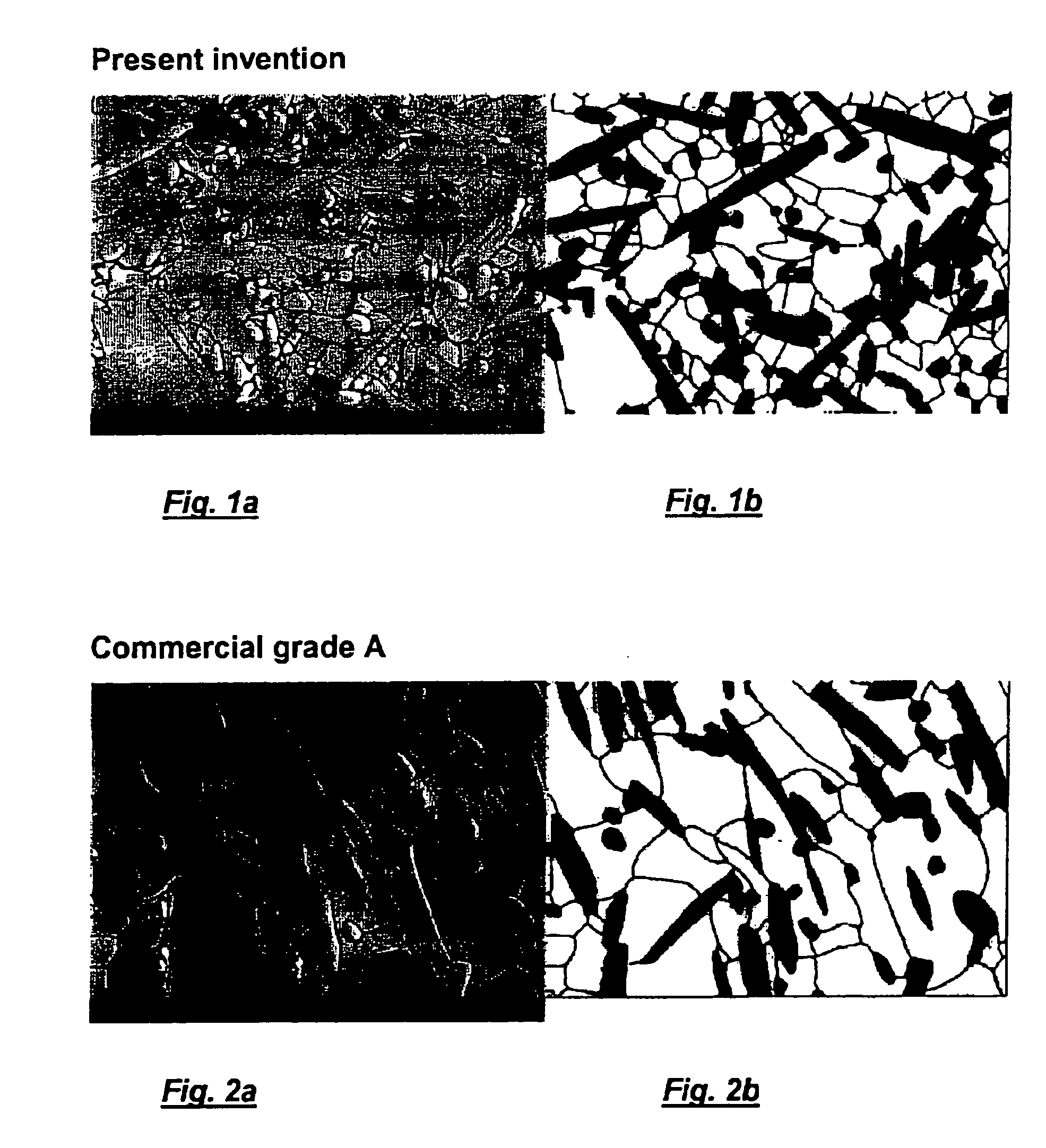Cutting tool insert and method for producing the same
a cutting tool and insert technology, applied in the direction of workpieces, metal-working equipment, turner accessories, etc., can solve the problems of diamond saw cutting, diamond saw cutting is a rather expensive part of the blank production process, and the stress concentration created by the defects cannot be eliminated by relaxation due to plastic deformation, etc., to achieve the effect of improving wear resistance and toughness behavior
- Summary
- Abstract
- Description
- Claims
- Application Information
AI Technical Summary
Benefits of technology
Problems solved by technology
Method used
Image
Examples
example 2
[0041] The samples (blanks) of Example 1 (prepared by hot pressing and rapid sintering, respectively) were tested in a grooving operation in heat resistant alloy of the type Inconel 718. A groove was widened in two cuts by a total of about 30%. Tool life was reached when the largest dimension of a damage on the flank or rake face exceeded 1 mm.
[0042] The following cutting conditions were used:
[0043] Cutting fluid: yes
[0044] Cutting speed: 250 m / min
[0045] Feed: 0.15 and 0.25 mm / rev
[0046] Depth of cut: 6 mm
1TABLE 1 Number of cycles to tool life Sintering Number of Cycles Feed Method Exp. 1 Exp. 2 Exp. 3 Exp. 4 Exp. 5 Average Relative 0.15 mm / rev Hot pressing 5 4 3 4 4 4 100 Rapid Sint. 6 7 5 7 5 6 150 0.25 mm / rev Hot Pressing 3 3 2 3 4 3 100 Rapid Sint. 3 5 3 3 5 3.8 128
[0047] At a feed rate of 0.15 mm / rev the increase in tool life is 50%, and at a feed rate of 0.25 mm / rev the increase is 28%.
example3
[0048] Using the samples (blanks) of Example 1, notch wear was measured in facing operation in heat resistant alloy of the type Inconel 718.
[0049] The following cutting conditions were used:
[0050] Cutting fluid: Yes
[0051] Cutting Speed: 220 m / min
[0052] Depth of cut: 1.5 mm
[0053] Feed: 0.11 mm / rev
[0054] Notch wear was measured after two cuts.
2TABLE 2 Notch wear (mm) after two cuts Sintering Notch wear (mm) after two cuts Method Exp. 1 Exp. 2 Exp. 3 Exp. 4 Exp. 5 Exp. 6 Average Relative Hot pressing 0.59 0.58 0.31 0.71 0.61 0.72 0.60 100 Rapid Sintering 0.43 0.21 0.27 0.58 0.46 0.66 0.45 75
[0055] With the cutting tool insert produced according to the rapid sintering method of the present invention, a reduction in notch wear to about 75% was achieved, or in other words, an increase in notch wear resistance of about 25% was achieved.
example 4
[0056] The samples produced according to the methods of Example 1 were characterized in respect of physical and mechanical properties and microstructural characteristics. The measured mechanical properties were density, hardness, fracture toughness, and strength, which are indicated in Table 3 below.
3TABLE 3 Mechanical Properties Density Hardness Fracture Toughness Strength Sintering Method g / cm.sup.3 HV10 GPa Mpam.sup.1 / 2* MPa** Hot Pressing 3.73 2080 .+-. 80 6.9 .+-. 0.6 995 Rapid Sintering 3.73 2110 .+-. 21 6.5 .+-. 0.2 1050 *Indentation (HV10) fracture toughness **Biaxial bending test, only two values
[0057] There are surprisingly only small differences between the two materials with respect to the physical and mechanical properties, considering the large differences in cutting performance, i.e., tool life and notch wear. It was highly surprising that two materials showing almost identical mechanical properties in standard tests exhibited large differences in cutting performance....
PUM
| Property | Measurement | Unit |
|---|---|---|
| Temperature | aaaaa | aaaaa |
| Percent by mass | aaaaa | aaaaa |
| Pressure | aaaaa | aaaaa |
Abstract
Description
Claims
Application Information
 Login to View More
Login to View More - R&D
- Intellectual Property
- Life Sciences
- Materials
- Tech Scout
- Unparalleled Data Quality
- Higher Quality Content
- 60% Fewer Hallucinations
Browse by: Latest US Patents, China's latest patents, Technical Efficacy Thesaurus, Application Domain, Technology Topic, Popular Technical Reports.
© 2025 PatSnap. All rights reserved.Legal|Privacy policy|Modern Slavery Act Transparency Statement|Sitemap|About US| Contact US: help@patsnap.com


